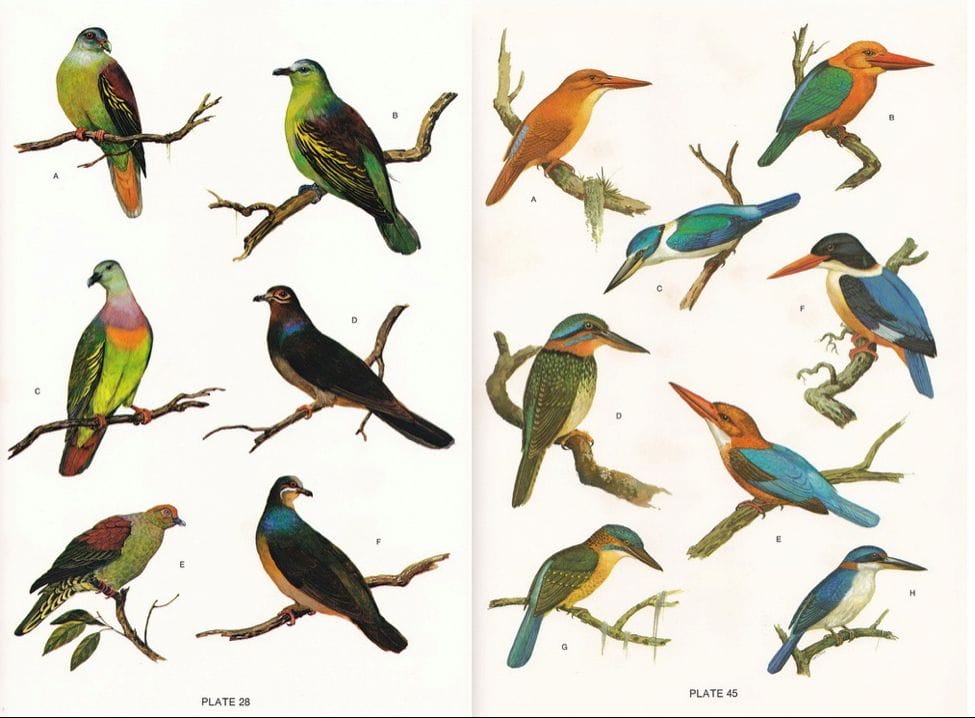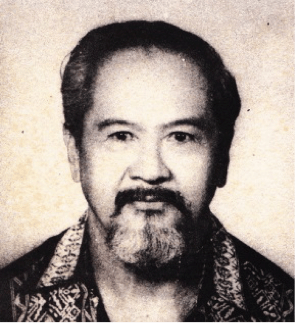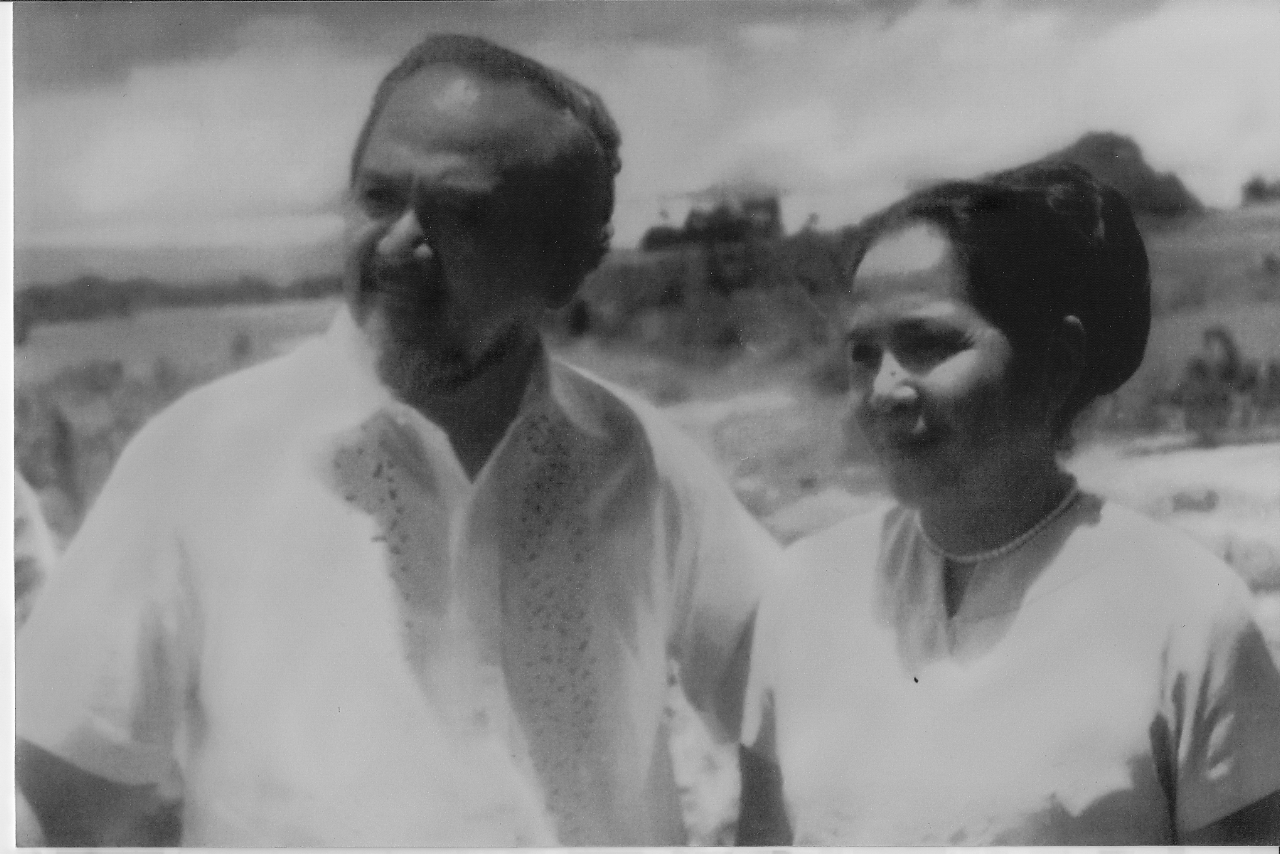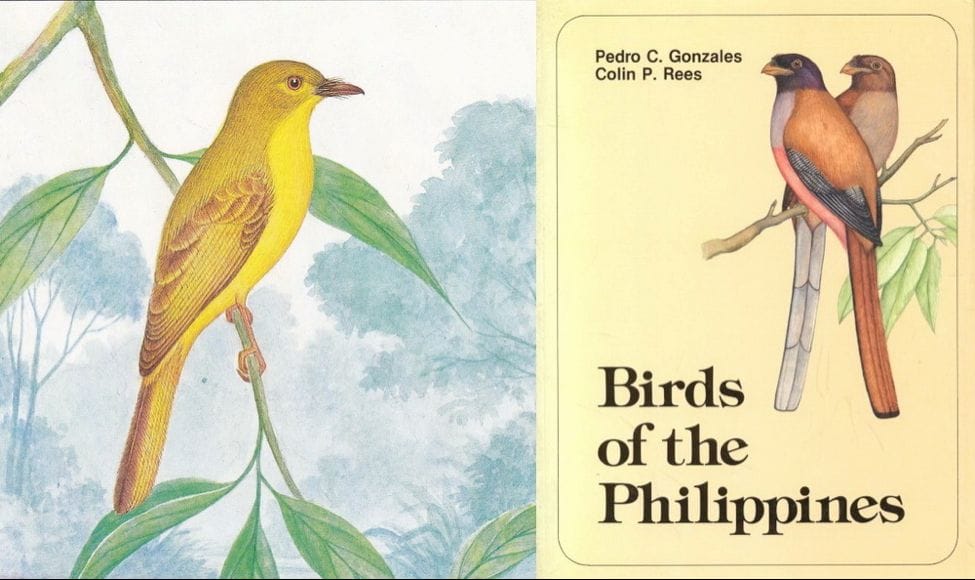by Christian Perez
The 7th and final installment in Christian Perez’s Short History of Philippine Bird books fleshes out the people behind the names that are familiar to us from their books found in bookshelves — Delacour, Mayr, Dupont. Then, finally we come across a Filipino — author, zoologist, and conservationist, Dr. Dioscoro Rabor the Father of Philippine Conservation. Christian Perez ends his history in 2000 with the publication of our beloved Kennedy guide. We get to know more about the authors Robert Kennedy, Pedro Gonzales, Edward Dickinson, Hector Miranda and Timothy Fisher.
Introduction
The years since the Philippine independence witnessed a new explosion of ornithological activities and importantly the birth of birdwatching as a hobby accessible to all. Hundreds of books and articles on Philippine birds were published during the period, and it is obviously not possible to cover them all. I had to focus on books with a general country-wide coverage, and continued to mention publications where new Philippine endemic species were first described. Few publications from this period are available online because copyright laws apply. On the other hand many of the books reviewed here can still be purchased at reasonable prices.
1. Delacour and Mayr: Birds of the Philippines (1946)

Jean Delacour (1890-1985) was a French-born American ornithologist. He went on numerous scientific expeditions to Indochina, particularly Vietnam, as well as to Venezuela, the Guianas and Madagascar. During the Second World War he lived in the US, working as a technical adviser for the New York Zoological Society (now known as the Wildlife Conservation Society). From 1952 to 1960 he was director of the Los Angeles County Museum of History, Science and Art.

Ernst Mayr (1904-2005) was a renowned German evolutionary biologist, taxonomist, tropical explorer, ornithologist, and historian of science. In 1927 he undertook an expedition to New Guinea for the American Museum of Natural History in New York, where he took a curatorial position in 1931. During his time at the museum he produced numerous publications on bird taxonomy. He influenced American ornithological research by mentoring young birdwatchers. He joined the faculty of Harvard University in 1953, where he also served as director of the Museum of Comparative Zoology from 1961 to 1970.
Delacour and Mayr jointly published Birds of the Philippines in New York in 1946. There is no record of their ever visiting the Philippines but they had an extensive knowledge of the birds of the Pacific region. This small 300-page book builds on McGregor’s and Hachisuka’s work. Like Walden in the 19th century, they describe Palawan species separately from the rest of the Philippines. They list about 450 species for the Philippines (except Palawan), plus about 20 for Palawan that are not in the first list, for a total of 470 species. About 70 species are illustrated with black-and-white drawings. Delacour and Mayr tended to lump species to an even greater extent than Hachisuka. For example all the Bleeding-hearts are lumped into one single species called “Bleeding-heart Pigeon, or Punalada” with 5 subspecies. The Besra and the Japanese Sparrowhawk are lumped into one called Asiatic Sparrow Hawk.

Some of their notes give an idea of the rapid decline of the population of some species since the early 20th century:
Spot-billed pelican: “Common on lakes on Luzon and Mindanao.”
Oriental Darter: “Common in the Philippines.”
Cotton Pygmy Goose: “Not very common in the Philippines, so far found breeding only in Luzon.”
Chinese Sparrowhawk: “Rare transient in the Philippines.”
Grey-faced Buzzard: “Most abundant about scattered trees in open fields, sometimes in immense flocks.”
Island Collared Dove: “It is extremely abundant.”
Spotted Dove: “This species seems to be very common on Balabac and Palawan.”
Philippine Cockatoo: “Common throughout the Philippines”
Siberian Rubythroat: “A common winter visitor to the Philippines.”
Eurasian Tree Sparrow: “Introduced into the Philippines, it has become common in Manila and other inhabited parts of Luzon, and on Cebu. Probably it will spread to other islands.”
Green-faced Parrotfinch: “Nothing is known of its habits and distribution. Probably lives in bamboos and travels in large flocks at irregular periods.” As we saw in the previous part of this article, Jean Delacour was credited for describing and naming the Green-faced Parrotfinch in 1937 jointly with Masauji Hachisuka.
2. Others authors of the 1950s
Herbert Girton Deignan (1906-1968) was an American ornithologist who described and named the Chocolate Boobook Ninox randi in Proceedings of the Biological Society of Washington in 1951.
Charles Vaurie (1906-1975) was a French-born American ornithologist who described the Cryptic Flycatcher in an article in American Museum Novitates in 1951. The type specimen was described as: “Adult male, Mt. McKinley, 3000 feet, Mt. Apo Range, Davao, Mindanao, Philippine Islands.”
Danish ornithologist Finn Salomonsen (1909-1983) described and named the Grand Rhabdornis and the Palawan Striped Babbler in Dansk Ornithologisk Forenings Tidsskrift (Journal of the Danish Ornithological Society) in 1953 and 1961 respectively. Salomonsen is best known for his work on the birds of Greenland. He went on an expedition to the Philippines in 1951-52.
3. Dupont: Philippine Birds (1971)
John Eleuthère Dupont (1938-2010) was an American ornithologist. His book Philippine Birds was published in 1971 by the Delaware Museum of Natural History, Greenville, Delaware. Dean Amadon wrote in the foreword: “A comparative new comer to the study of Philippine ornis, Dupont amassed at the Delaware Museum of Natural History, which he founded, one of the finest collections of Philippine birds in existence. He has also led significant expeditions in the Philippines, starting in 1958; and anyone who knows John Dupont will realize that, once in the islands, he heads for the nearest mountains and jungles: he is not one to dawdle in the gardens of local officials.”

The book describes and illustrates in full color about 510 species of Philippine birds with an extensive coverage of subspecies. He also provides comprehensive taxonomic references and history. Many of the common English names he uses are quite different from the ones in the Kennedy guide and the current WBCP checklist. It was a rather heavy book with hard cover that was not practical to carry around as a field guide. Like Delacour and Mayr, Dupont lumps all the Bleeding-Heart species into one species called Bleeding-Heart Pigeon, this time with seven subspecies.

Dupont’s life ended in tragedy. He was a scion of the extremely wealthy Dupont family. Aside from being a passionate ornithologist he was a conchologist, philatelist, coach, and sports enthusiast. He founded and directed the Delaware Museum of Natural History in 1957, which opened in 1972. In the 1980s, he established a wrestling facility at his Foxcatcher Farm, and became a prominent supporter for amateur sports in the United States. In the 1990s his behavior became more and more erratic and paranoid, but his wealth shielded him. In 1997, he was convicted of the inexplicable murder of his friend Dave Schultz, an Olympic champion freestyle wrestler. He was found to be mentally ill but not insane and was sentenced to prison, where he died thirteen years later in 2010. Part of his life is depicted in the 2014 movie Foxcatcher.
Dupont and Dean Amadon are jointly credited for describing and naming the Ashy-breasted Flycatcher Muscicapa randi in Nemouria; occasional papers of the Delaware Museum of Natural History in 1970. Dean Arthur Amadon (1912- 2003) was an American ornithologist and an authority on birds of prey. In 1937 he joined the American Museum of Natural History in New York and was Chairman of the Department of Ornithology there from 1957 until 1973. He was president of the American Ornithologists’ Union from 1964 to 1966.
The Brown-banded Rail Lewinia mirificus was described and named by American ornithologist Kenneth Parkes and Amadon in 1959 in the Wilson Bulletin.
The Visayan Miniature Babbler Micromacronus leytensis was described and named by Amadon in 1962 in the magazine The Condor.
4. Rabor: Philippine Birds and Mammals (1977)
Dioscoro Rabor (1911-1996) was a prominent Filipino zoologist and conservationist. An excellent In Memoriam article by Kennedy and Miranda was published in the magazine The Auk in 1998, from which I extracted the following information.
Rabor received an M.S. from UP in 1934 and studied at Yale University in 1957-58 under S. Dillon Ripley. He held some 30 positions with professorships at Silliman University (1947 to 1967), Mindanao State University (1967 to 1975) and UP Los Baños (1975 to 1976). After his retirement he was consultant in Wildlife Biology and Management at UPLB until he became ill in 1992. Rabor’s passion for nature consumed his whole life and the lives of his family as well. From 1935 to 1977, he led more than 50 expeditions in the Philippines. His wife Lina joined him on most of these trips, and as each child was born, they came along too. Each of their four daughters is named after a bird (Iole Irena, Nectarinia Juliae, and Ardea Ardeola) or a fish (Alectis Cyrene), and all became physicians. His field catalog for birds alone approached 60,000 entries and his specimens were deposited in institutions such as the Delaware Museum of Natural History, Smithsonian Institution, Rabor Memorial Collection at UPLB, and American Museum of Natural History. Eight species and 61 subspecies were named from Rabor’s collections. He authored 87 scientific and popular books and articles and was a member of the planning committees of several International Ornithological Congresses.

I quote from the In Memoriam 1998 article: “His contribution to Philippine ornithology may never be duplicated. Clearly his work, particularly his campaign to alert the world to the endangered status of the Philippine (Monkey-eating) Eagle, has not gone unnoticed. His energy helped launch a generation of naturalists and the rapidly expanding conservation efforts that we see in the Philippines today. Without question he should be known as the ‘Father of Philippine Conservation.’”

In 1977 the UP Press published his Philippine Birds and Mammals in Quezon City. This is an illustrated book that does not attempt to cover all known bird species but rather all families of Philippine birds with a few representative species of each family. The book is illustrated with black-and-white line drawings by Romulo Capalad and Porfirio Castañeda.

Rabor’s illustrator Porfirio Castañeda painted 30 beautiful large plates of Philippine birds that were published in a loose leaf portfolio format by the Ayala Museum in 1977 with an introduction by Rabor.

In 1986 Rabor authored the birds section of a series of publications by the Ministry of Natural Resources and UP called Guide to Philippine Flora and Fauna, where he describes 70 species of passerines of which 61 are endemic. All species are illustrated with black-and-white drawings.
Rabor worked closely with other ornithologists to describe and name the following new endemic species: Negros Scops Owl by Canadian ornithologist Austin Rand in 1950 in Miscellaneous Papers of the Chicago Natural History Museum from a specimen taken by Rabor; Negros Striped Babbler by Rand and Rabor in 1952 in Miscellaneous Publications of the American Museum of Natural History; Negros Fruit Dove by Ripley and Rabor in 1955 in Postilla. S. Dillon Ripley was an American ornithologist who served as Secretary of the Smithsonian Institution from 1964 to 1984 and was Rabor’s professor at Yale University in 1957. Postilla is the bulletin of the Yale Peabody Museum of Natural History.
Cordillera Ground Warbler Robsonius rabori was described by Rand in 1960 in Fieldania and named after Rabor. Fieldiana is a publication of the Chicago Natural History Museum.
Red-eared Parrotfinch was described and named by Ripley and Rabor in 1961 in Postilla with a nice color illustration.

Whiskered Flowerpecker was described and named by Ripley and Rabor in 1966 in Proceedings of the Biological Society of Washington; Bicol Ground Warbler by Rand and Rabor in 1967 in Fieldiana; Furtive Flycatcher by Ripley and American ornithologist Joe Marshall in 1967 in Proceedings of the Biological Society of Washington; and Mindanao Scops Owl and Mindanao Miniature Babbler by Ripley and Rabor in 1968 in Proceedings of the Biological Society of Washington.
5. Gonzales and Rees: Birds of the Philippines (1988)
Pedro Gonzales (born 1932) is a Filipino zoologist. He worked in many fields from marine biology to ornithology and led numerous expeditions throughout the country from the bottom of the seas to the tops of mountains. In 1988 he was Head of the Zoology Division of the National Museum. He retired from that position in 1997 but to this day he continues to observe birds, particularly their breeding behavior and local distribution.
Colin Rees is a British biologist who was at the time Head of the Environment Unit at the Asian Development Bank. In 1988 they published in Manila Birds of the Philippines, a small richly illustrated book intended for the general public that describes 129 species arranged by habitat (Marine and Shoreland; Swampland and Riverine; Forest; Grassland and Scrubland; and Agricultural Areas, Villages and Towns).


6. Dickinson et al: The Birds of the Philippines – An Annotated Checklist (1991)
In 1991 the British Ornithologists’ Union published The Birds of the Philippines – An annotated check-list, by Edward Dickinson, Robert Kennedy and Kenneth Parkes.
Edward Dickinson (born 1938) is a British amateur ornithologist with a special interest in Southeast Asian birds. He spent eight years in Thailand in 1962-70 and five years in the Philippines in 1973-79 working for Nestlé. In 1975, he co-authored A Field Guide to the Birds of Southeast Asia with American ornithologist and later tour guide Ben King. He has been a scientific associate with the Field Museum of Natural History in Chicago, the National Museum of Natural History of the Netherlands (now Naturalis), Leiden and The Natural History Museum, London. He has been a member of the Standing Committee on Ornithological Nomenclature (of the IOC) for some ten years and is a member of the ZooBank Steering Committee of the International Commission on Zoological Nomenclature.

Kenneth Parkes (1922-2007) was an American ornithologist, a senior curator of birds at the Carnegie Museum of Natural History in Pittsburgh, Pennsylvania, and the author of numerous articles on the biology and systematics of birds. As we have seen earlier, he was the co-discoverer of the Brown-banded Rail together with Dean Amadon.

The Birds of the Philippines – An annotated check-list is a large 500-page hardcover book that describes 556 Philippine bird species. The books starts with an extensive coverage of the biogeography, climate, and vegetation of the Philippines, chapters on Philippine bird breeding, migration and conservation, and an outline of the history of ornithological exploration of the Philippines. For each species and subspecies, the book provides the known distribution with extremely detailed taxonomic references and history. There is no bird physical description and no illustration except for a few color photographs mostly of habitat. The Check-list was an invaluable reference for the preparation of this article and clearly the precursor of the Kennedy guide.

The book contains the first appearance of the common name Cinnamon Ibon. Many birdwatchers have been wondering how this name came about. We have seen earlier that the bird was first described and named by Ernst Hartert in 1903 as Hypocryptadius cinnamomeus. In 1909 McGregor gave it the common English name Cinnamon Hypocryptadius and placed it in the White-eyes family. Both Delacour (1946) and Dupont (1971) called it Cinnamon White-eye. I now quote from a 2010 article by Don Roberson: “What used to be called the ‘Cinnamon White-eye’ has long been a mysterious avian. When I first visited the Philippines in 1990 on a tour with Ben King, he had already reached the conclusion this bird was not a white-eye. He coined the name ‘Ibon’ for its genus (Hypocryptadius). […] The word ‘Ibon’, he said, meant ‘little bird’ in a local language.” The Cinnamon Ibon is now placed in the Old World Sparrows family, like the Eurasian Tree Sparrow, but is has been shown to have diverged from other sparrows about 31 million years ago, while the Eurasian Tree Sparrow is thought to be of recent human introduction in the Philippines.
In 1985, Kennedy, Dickinson and Bruce Murray (recruited for his bibliographic skills and owner of the most extensive collections of references on South-east Asian birds), published Bibliography of Philippine Ornithology in the magazine Nemouria, a useful reference for any ornithology historical research.
7. Kennedy et al: A Guide of the Birds of the Philippines (2000)
In 2000 Oxford University Press published in Oxford and in New York A Guide to the Birds of the Philippines, by Robert Kennedy, Pedro Gonzales, Edward Dickinson, Hector Miranda and Timothy Fisher. We have already encountered Gonzales and Dickinson earlier in this article.
Robert Kennedy (born 1948) is an American ornithologist who began work in the Philippines in 1972 as a Peace Corps volunteer assigned to help study and develop a conservation program for the Philippine Eagle. He was a professor at Yale University and Washington State University, and Director of Natural History Collections and Research at the Cincinnati Museum of Natural History. He travelled to the Philippines 31 times for the preparation of this book. He has authored more than 75 popular and scientific papers and books, many of them jointly with the other authors of the book.

Hector Miranda (born 1960) started as a biologist with the Philippine Eagle Conservation Program in 1981 when he travelled extensively in the forested mountains of Luzon and Mindanao. He received a M.S. in Zoology from UPLB in 1987 and a PhD from the University of Cincinnati in 1997. He has authored a large number of scientific papers during his career. He is currently Associate Professor and Interim Assistant Dean for Academic Affairs at the Thomas F. Freeman Honors College in Houston.

Tim Fisher (1947-2010) was an English birdwatcher who started birding when he was 8 years old. He was posted in the Philippines by a multinational company in 1978, where he settled for the rest of his life. He studied birds during his spare time and travelled extensively throughout the country. He authored several papers on bird distribution records. He organized and led numerous birdwatching tours through his company Philippine Nature Tours. He was a founding member of the Wild Bird Club of the Philippines and a major contributor of the introduction of birdwatching in the Philippines. He is remembered fondly by all those who have met him.

The “Kennedy Guide”, as the book is often called, lists and illustrates 572 species of Philippine birds. It is well known to all Philippine birders and needs no further introduction or description here. It is the first comprehensive Philippine bird book that can be conveniently used as a field guide by birdwatchers.
Gonzales & Kennedy described and named the Panay Striped Babbler in 1990 the Wilson Bulletin. Kennedy, Gonzales and Miranda described Lina’s Sunbird Aethopyga linaraborae in 1997 in The Auk and named it in honor of Dioscoro Rabor’s wife Lina Rabor.


The Pinsker’s Hawk-Eagle was described by Austrian ornithologists Monika Preleuthner and Anita Gamauf in 1998 in the Journal of Raptor Research and named in honor of Austrian zoologist Wilhem Pinsker. The Pinsker’s Hawk-Eagle is mentioned in the Kennedy Guide as a subspecies of the Philippine Hawk-Eagle.
The Bukidnon Woodcock is assigned the generic name Scolopax sp. in the Kennedy guide as the bird seen and heard by Tim Fisher in 1993 and a specimen taken in 1995 in Mt. Kitanglad were identified as an undescribed species. It was formally described and named Scolopax bukidnonensis by Kennedy, Fisher, Harrap, Diesmos and Manamtam in 2001 in an article published in Forktail magazine.
Conclusion
This short history spanning three centuries starts in 1702 with Kamel’s first Philippine bird list and ends in 2000 with the publication of the Kennedy Guide. The 18th century was an era of pioneers (Kamel and Sonnerat), taxonomists and encyclopedists. The 19th century was an era of exploration, where all nooks and corners of the Philippines were visited by ornithologists and most Philippine birds were discovered, described and named by foreigners with hardly any colonial government support. It was a time when every new taxon was a new species (no subspecies) and when ornithologists could read and write in Latin and did not use common names. The 20th century would see the discovery of the remaining endemic species, the use of common names for birds thus making bird books accessible to the general public, the lumping of many subspecies into a smaller number of species, official government support for ornithology and science in general, the birth of birdwatching as a hobby, and the emergence of Filipino ornithologists.
One thing that strikes me looking back at those three centuries is that the roughly 90 authors, collectors or explorers that we have mentioned were all men except for two women in 1998. This short history ends in 2000, but if we push a little to 2004 when a new endemic species was discovered (Calayan Rail Gallirallus calayanensis Allen, Oliveros, Española, Broad & Gonzalez 2004), we encounter another woman credited for naming a new Philippine endemic species (jointly with four others), and the only Filipina: Carmela Española. Congratulation Lala for breaking new ground!
When I first started to use the Kennedy guide I was amazed by the enormous amount of information it contained and the incredible data collecting effort that had gone into it. The research I did during the preparation of this article shed light on the slow and gradual process that started with Kamel in 1702, each author or explorer building on earlier work, confirming or infirming information, and adding to the list of birds. It was fascinating to see how Martens built on Sonnerat, Walden on Martens, then how Ogilvie-Grant, McGregor, Hachisuka, Dupont, Rabor, Dickinson and finally Kennedy built on previous work to incrementally add to our knowledge. History truly gives another dimension to our understanding of Philippine birds.
Christian Perez
March 2015
A Short History of Philippine Bird Books – Part 1
A Short History of Philippine Bird Books – Part 2 Remainder of the 18th Century
A Short History of Philippine Bird Books – Part 3 Early 1820s to late 1860s
A Short History of Philippine Bird Books – Part 4 the 1870s
A Short History of Philippine Bird Books – Part 5 1881 to 1899
A Short History of Philippine Bird Books – Part 6 American Period

Pingback:April 2015 | e-BON
I am fascinated by these pictures and write-ups about Professor Dioscoro Rabor who was one of the great Biology professors at Silliman University in Dumaguete , Philippines. I happened to be in his Biology class
in the early 60’s when in Pre-Med at Silliman. He was strict but very inspiring teacher and after all these
years you can appreciate his great accomplishments. Long live his memory! from Dr. Lowell Taclob